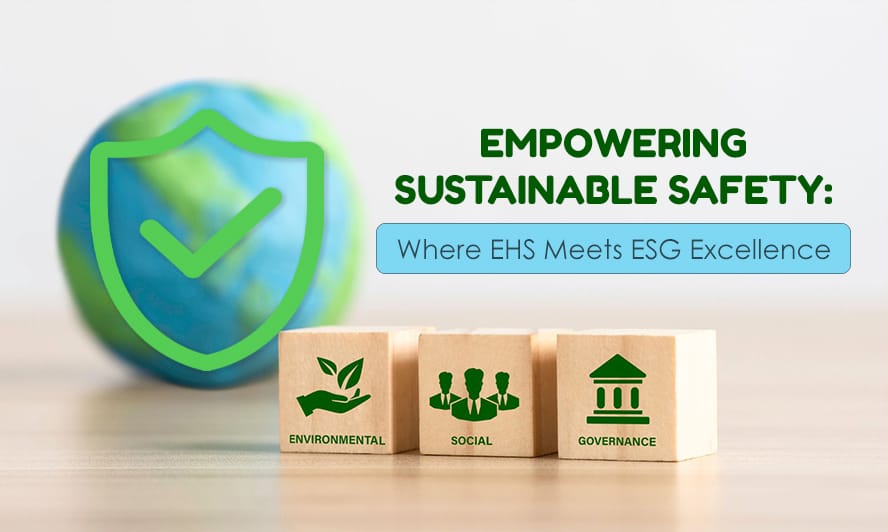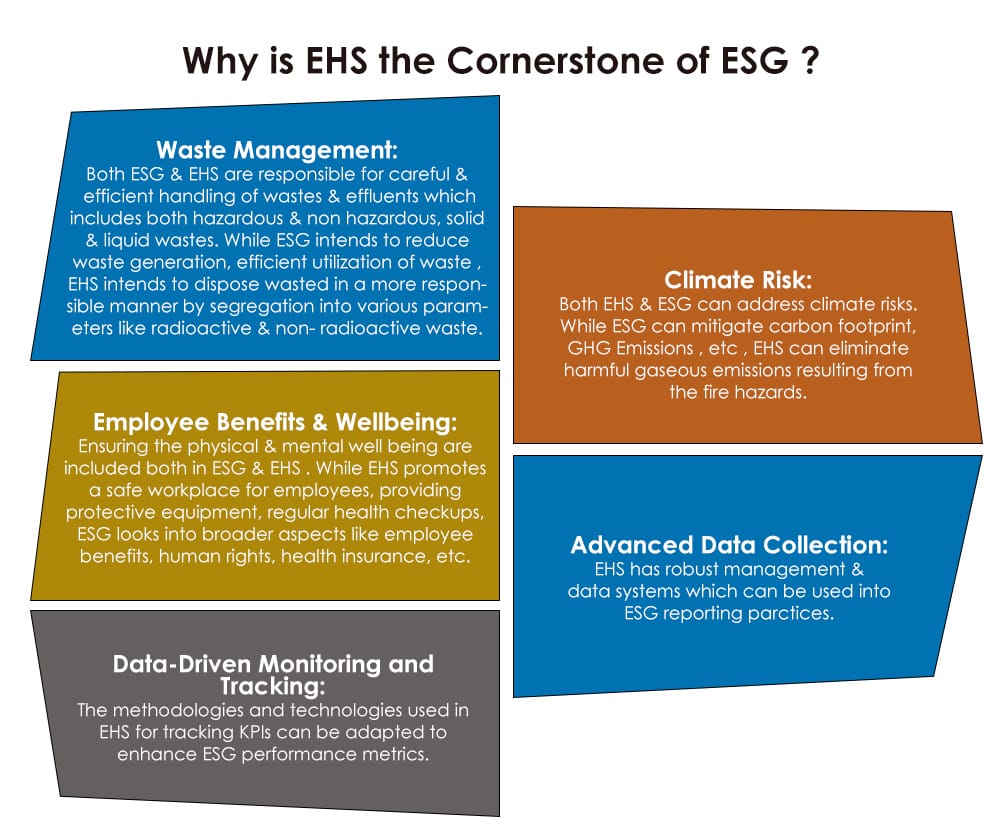"Empowering Sustainable Safety: Where EHS Meets ESG Excellence"

By: Kinkini Chakraborty, Shubham Pal, Anurag Bajpai and Shweta Shukla
For a long time, ESG and EHS were seen as a separate entity rather than a double engine which can play a pivotal role in significantly advancing any business growth. Professionals and leaders from EHS have long ago recognized the idea of integrating ESG and EHS which can drive the overall business values and through that bring value to organizations’ ESG agendas.
With the rising emphasis on ESG around the world, now it is the time to reframe both ESG and EHS together on how to incorporate learnings from EHS into ESG to drive a meaningful change in the organization.
As apprehended there is a direct relationship between ESG and EHS with issues such as waste management, climate risk, employee safety, as well as mental health and wellbeing, sitting at the intersection of the two functions. Data collected by the EHS team around these issues can be directly fed into ESG reporting, strategies, and performance tracking.
However, EHS benefits ESG in ways that go far beyond compliance, disclosure, and data collection. Since EHS has been ingrained in many organizations for many years, those in charge of EHS activities have the ability to truly impact change.
As contemporary issues like climate change, global warming, carbon footprint, and impact on biodiversity are more familiar with a business’s reputation, the synergies between EHS and ESG are receiving greater attention. Prominent EHS experts are approaching EHS management in today's workplaces with a modern perspective. This strategy takes into account the organizational human factors (such as leadership, behaviour, and cultural shift) in addition to providing workers with the systems, procedures, and equipment they need to keep safe and well as safeguard and rehabilitate the environment.
The stakes are high since ESG disclosures and performance are being scrutinized more closely by stakeholders, investors, and the general public. Companies run the danger of paying fines to regulators, losing current and future business, having more staff turnover, and suffering long-term harm to their brand. We can assist ESG in avoiding the mistakes of the past and accelerating its maturation by utilizing these strategic linkages between the EHS and sustainability functions.


What are the key components of an EHS system?
- Incident Reporting captures, tracks, investigates, and reports on all incidents and near-misses, including injuries and illnesses, spills, property damage, and vehicle incidents.
- Audit Management includes scheduling, tracking, data collection, and reporting for all internal or external audits to simplify and ensure compliance across all company locations and operating jurisdictions.
- Document Control improves document management across the complete lifecycle of your organization’s compliance efforts and activities. It controls access to sensitive files, forms, and reports while preventing errors, reducing risk, and improving visibility.
- Training Management makes it easy to plan and track EHS training for a global workforce. Worker education and training are critical to building a robust and resilient health & safety culture while staying on top of diverse and always-evolving industry regulations.
- Regulatory compliance involves adhering to essential EHS regulations and directives and being able to demonstrate this compliance to the relevant authorities. This requires understanding the standards and regulations specific to your industry and locations, collecting and analyzing the necessary data, and proving compliance through inspections and audits.
What are the benefits of an EHS Management System?
- Preventing workplace incidents, accidents, injuries and illnesses
- Improved operational efficiency
- Easier regulatory compliance
- More educated and engaged workers
- Reduced Administration Costs

To promote collaboration between ESG and EHS teams, strategies implemented are in the following ways:
Encourage conversation and involvement: Promoting transparent communication and teamwork between ESG and EHS teams, thereby cultivating an environment of cooperation and common goals.
Align Metrics and Narratives: Create metrics and incorporate them into ESG reporting frameworks to capture leading indicators of EHS performance. Write stories that emphasize how EHS activities contribute significantly to sustainability and social responsibility.
Facilitate Cross-Training and Education: Exchange of knowledge between EHS and ESG teams, thus empowering both teams to develop skills, upgrade & appreciate the challenges & opportunities faced by each other
Integrate EHS into ESG Strategy: EHS norms and framework should go hand in hand with ESG reporting
EHS should not be seen as a separate set of compliance processes but as a fundamental driver of ESG and overall business performance. By integrating EHS principles and practices into ESG strategies, companies can enhance their reputation, ensure regulatory compliance, and create a healthier and more sustainable work environment. This integration not only supports current business needs but also prepares companies for future challenges in the fast-paced and complex global market.

GreenTree Global is one of the leading Sustainability Consulting organizations providing Energy Efficiency & Climate Change Services like Integrated Sustainability Services, Carbon Accounting & Trading, Energy & Carbon Assessment (Buildings, MSME, DISCOM), ECBC & ENS Compliances (WBP Method), Feasibility and Green Rating Certification, ESG & EHS Services, MSME Energy Efficiency & Financing, etc.
We are thus, pleased to announce our Integrated Workplace Services for EHS & Sustainability in Building’s domain. These services include the following at a broad level:
- ISO 450001- An audit of ISO 45001 Occupational Health and Safety Management
- System documentation including the scope of the system, objectives, and any relevant policies and documentation that support the operation of the system
- Legal Authority Submission Related EHS Compliances
- Consultancy Services to Apply & Participate in Scaling EHS Certifications & Awards from Renowned Institutions.
- Submission & Preparation of all Environmental statement FORM V of all sites to government authorities (traveling cost included in client scope)
- Assess the Training Need Analysis (Working at height, BBS, Material Handling, Accident Investigation, etc.,) and prepare yearly third-party training & internal training calendar for the development of the project base team.
- Conduct HSE External Audit & follow up by coordinating top management & Project In-charge on the closing of external audit points.
- Provide consultative assistance to company safety officers, Asst. Managers, Managers, GM & VP level on ways to improve EH&S performance and large-scale construction projects.
- Lead and participate in the Corporate EHS Core team and Continuous Improvement efforts within the organization.
- Apply & participate on behalf of the organization in the various annual Awards & Certifications in the field of Environment, Health, and safety.
- Awards like Safety Health & Environment (SHE) Award- CII.
Clients: ATS Homekraft HappyTrails Residential Towers
Scope of work:
- Safety Management which includes construction safety, fire safety & electrical safety.
- Health Management which includes indoor air quality, water quality
- Environment Management includes sustainable practices, energy management, water management


Contact us:
+91 8076654783, +91 9811122522
[email protected], [email protected]



